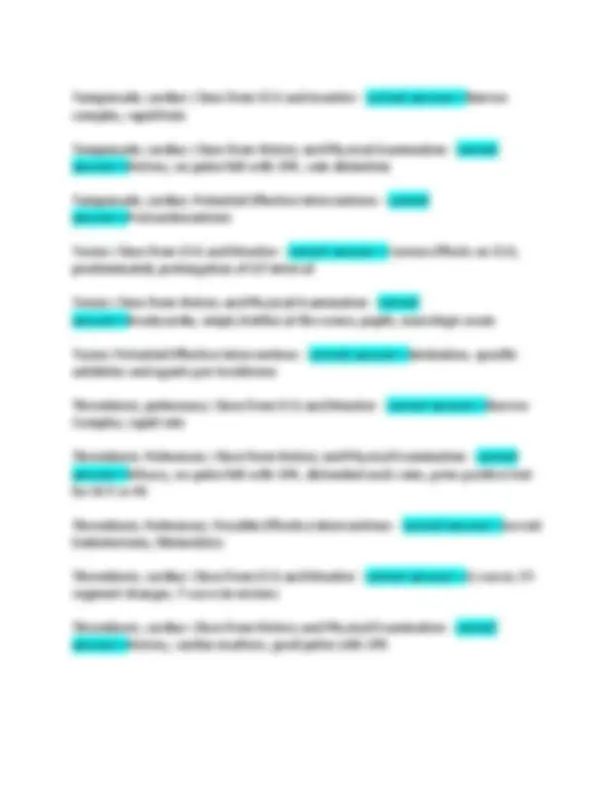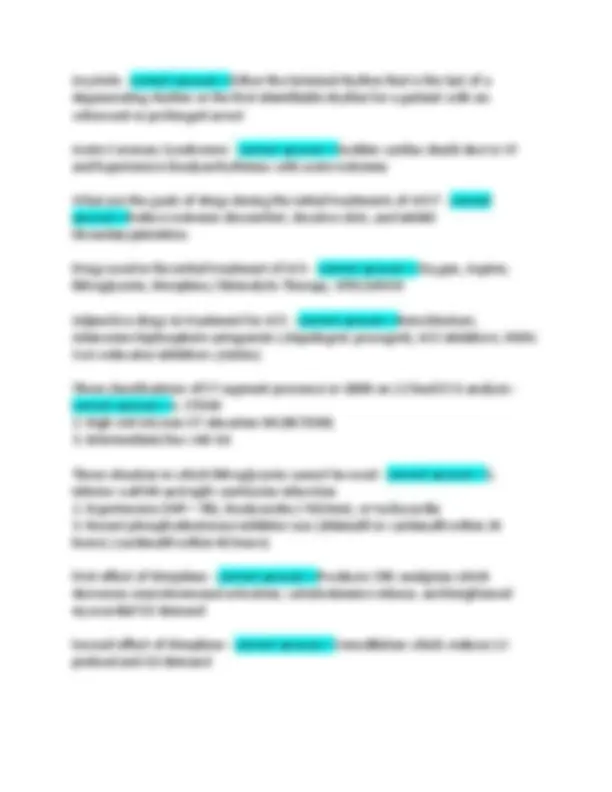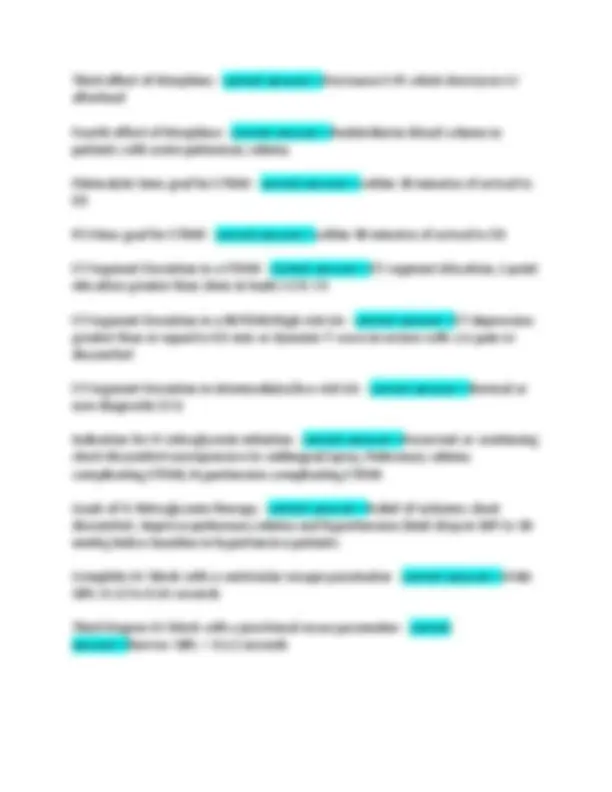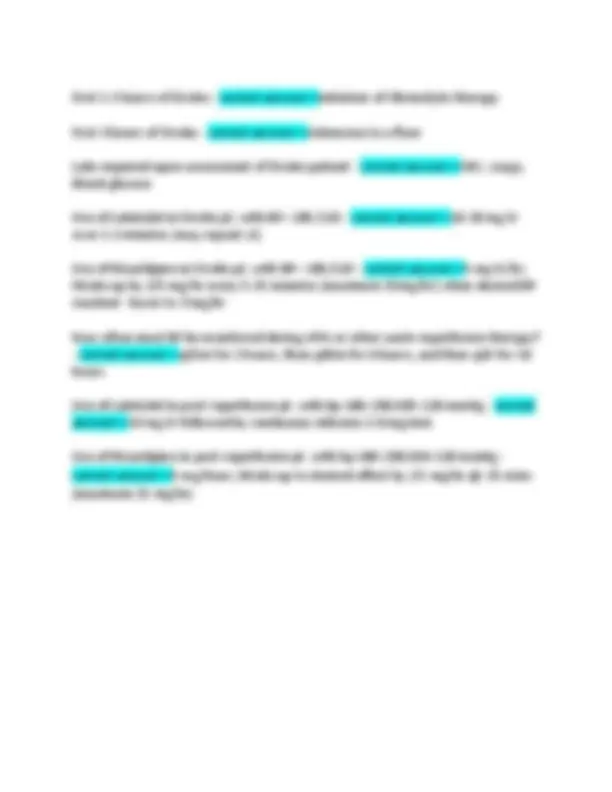






Study with the several resources on Docsity

Earn points by helping other students or get them with a premium plan


Prepare for your exams
Study with the several resources on Docsity

Earn points to download
Earn points by helping other students or get them with a premium plan
Community
Ask the community for help and clear up your study doubts
Discover the best universities in your country according to Docsity users
Free resources
Download our free guides on studying techniques, anxiety management strategies, and thesis advice from Docsity tutors
ACLS Study Verified Exam 2025-2026 With Correct Verified Answers Dopamine - correct answer>>A catecholamine-like agent that stimulates both alpha and beta adrenergic receptors Norepinephrine - correct answer>>A potent vasoconstrictor and inotropic agent; effective for a patient with severe hypotension and a low total peripheral resistance who doesn't respond to less potent drugs such as dopamine, phenylephrine, or methoxamine Optimal temperature for therapeutic hypothermia - correct answer>>32 - 34 degrees Celcius for 12 - 24 hours Hypovolemia: Clues from ECG and Monitor - correct answer>>Narrow Complex & Rapid Rate Hypovolemia: Clues from history and physical examination - correct answer>>History, glat neck veins Hypovolemia: Potential Effective Interventions - correct answer>>Volume Infusions
Typology: Exams
1 / 8

This page cannot be seen from the preview
Don't miss anything!





Dopamine - correct answer>>A catecholamine-like agent that stimulates both alpha and beta adrenergic receptors Norepinephrine - correct answer>>A potent vasoconstrictor and inotropic agent; effective for a patient with severe hypotension and a low total peripheral resistance who doesn't respond to less potent drugs such as dopamine, phenylephrine, or methoxamine Optimal temperature for therapeutic hypothermia - correct answer>> 32 - 34 degrees Celcius for 12 - 24 hours Hypovolemia: Clues from ECG and Monitor - correct answer>>Narrow Complex & Rapid Rate Hypovolemia: Clues from history and physical examination - correct answer>>History, glat neck veins Hypovolemia: Potential Effective Interventions - correct answer>>Volume Infusions Hypoxia: Clues from ECG and Monitor - correct answer>>Slow rate Hypoxia: Clues from history and Physical Examination - correct answer>>Cyanosis, blood gases, airway problems Hypoxia: Potential Effective INterventions - correct answer>>Oxygenation, ventilation, advanced airway Hydrogen ion (acidosis): Clues from ECG and Monitor - correct answer>>Smaller- amplitude QRS complexes Hydrogen Ion: Clues from History and Physical Examinations - correct answer>>History of diabetes, bicarbonate-responsive preexisting acidosis, renal failure
Hydrogen ion: Potential Effective Interventions - correct answer>>Ventilation, sodium Bicarbonate Hyperkalemia: Clues from ECG and Monitor - correct answer>>T waves taller and peaked, P waves get smaller, QRS widens, sine-wave PEA Hyperkalemia: Clues form history and Physical Examination - correct answer>>History of renal failure, diabetes, recent dialysis, dialysis fistulas, medications Hyperkalemia: Potential Effective Interventions - correct answer>>Calcium Chloride, Sodium bicarbonate, Glucose plus insulin, Possibly albuterol Hypokalemia: clues from ECG and monitor - correct answer>>T waves flatten, prominent U waves, QRS widens, QT prolongs, Wide-complex tachycardia Hypokalemia: Clues from history and physical examination - correct answer>>Abnormal loss of potassium, diuretic use Hypokalemia: Potential Effective Interventions - correct answer>>Add magnesium if cardiac arrest Hypothermia: Clues from ECG and Monitor - correct answer>>J or Osborne waves Hypothermia: Clues from History and Physical Examination - correct answer>>History of exposure to cold, central body temperature Tension pneumothorax: Clues from ECG and Monitor - correct answer>>Narrow Complex, slow rate Tension pneumothorax: Clues from History and Physical Examination - correct answer>>History, no pulse felt with CPR, neck vein distention, tracheal deviation, unequal breath sounds, difficult to ventilate patient Tension Pneumothorax: Potential Effective Intervention - correct answer>>Needle Decompression, tube thoracostomy
Asystole - correct answer>>Either the terminal rhythm that is the last of a degenerating rhythm or the first identifiable rhythm for a patient with un- witnessed or prolonged arrest Acute Coronary Syndromes - correct answer>>Sudden cardiac death due to VF and hypotensive bradyarrhythmias with acute ischemia What are the goals of drugs during the initial treatments of ACS? - correct answer>>Relieve ischemic discomfort, dissolve clots, and inhibit thrombin/plateletes Drugs used in the initial treatment of ACS - correct answer>>Oxygen, Aspirin, Nitroglycerin, Morphine, Fibrinolytic Therapy, UFH/LMWH Adjunctive drugs in treatment for ACS - correct answer>>Beta blockers, Adenosine Diphsophate antagonists (clopidogrel, prasugrel), ACE inhibitors, HMG- CoA reducatse inhibitors (statins) Three classifications of ST segment presence or LBBB on 12-lead ECG analysis - correct answer>>1. STEMI
Third effect of Morphine - correct answer>>Decreases SVR which decreases LV afterload Fourth effect of Morphine - correct answer>>Redistributes blood volume in patients with acute pulmonary edema Fibrinolytic time goal for STEMI - correct answer>>within 30 minutes of arrival to ED PCI time goal for STEMI - correct answer>>within 90 minutes of arrival to ED ST-Segment Deviation in a STEMI - correct answer>>ST-segment elevation; J-point elevation greater than 2mm in leads V2 & V ST-Segment Deviation in a NSTEMI/High-risk UA - correct answer>>ST depression greater than or equal to 0.5 mm or dynamic T-wave inversion with c/o pain or discomfort ST-Segment Deviation in Intermediate/low-risk UA - correct answer>>Normal or non-diagnostic ECG Indication for IV nitroglycerin initiation - correct answer>>Recurrent or continuing chest discomfort unresponsive to sublingual/spray; Pulmonary edema complicating STEMI; Hypertension complicating STEMI Goals of IV Nitroglycerin therapy - correct answer>>Relief of ischemic chest discomfort, Improve pulmonary edema and hypertension (limit drop in SBP to 30 mmHg below baseline in hypertensive patients Complete AV block with a ventricular escape pacemaker - correct answer>>Wide QRS: 0.12 to 0.14 seconds Third-Degree AV block with a junctional escae pacemaker - correct answer>>Narrow QRS: < 0.12 seconds
Polymorphic QRS appearance - correct answer>>Indicates Torsades de Pointes Polymorphic VT treatment - correct answer>>high-energy Unsynchronized defibrillationd Monophasic Cardioversion Joules - correct answer>>initial 200-J synchronized shock Biphasic Cardioversion Joules - correct answer>>initial 120-200 J synchronized shock Initial energy dose for Atrial flutter and SVT - correct answer>> 50 - 100 J Monitor lead attachments for cardioversion - correct answer>>White to right Red to ribs Left over to the left shoulder Initial energy dose for Unstable Monomorphic VT - correct answer>>100 Joules Which concurrent drugs require a reduced 3 mg dose of adenosine? - correct answer>>Dipyridamole or carbamazepine Which concurrent drugs require a larger dose of adenosine? - correct answer>>Theophylline, caffeine, or theobromine Which population is adenosine contraindicated and why? - correct answer>>Asthmatic patients because it can cause bronchospasm 8 D's of Stroke Care - correct answer>>Detection, Dispatch, Delivery, Door, Data, Decision, Drug, Disposition First 10 minutes of Stroke - correct answer>>general assessment, Physician, order noncontrast CT First 25 minutes of Stroke - correct answer>>Neurologic assessment, CT scan First 45 minutes of Stroke - correct answer>>CT scan interpretation
First 1-3 hours of Stroke - correct answer>>Initiation of Fibrinolytic therapy First 3 hours of Stroke - correct answer>>Admission to a floor Labs required upon assessment of Stroke patient - correct answer>>CBC, coags, blood glucose Use of Labetalol in Stroke pt. with BP> 185/110 - correct answer>> 10 - 20 mg IV over 1-2 minutes (may repeat x1) Use of Nicardipine in Stroke pt. with BP> 185/110 - correct answer>>5 mg IV/hr, titrate up by 2/5 mg/hr every 5-15 minutes (maximum 15mg/hr) when desired BP reached - lower to 3 mg/hr How often must BP be monitored during rtPA or other acute reperfusion therapy?